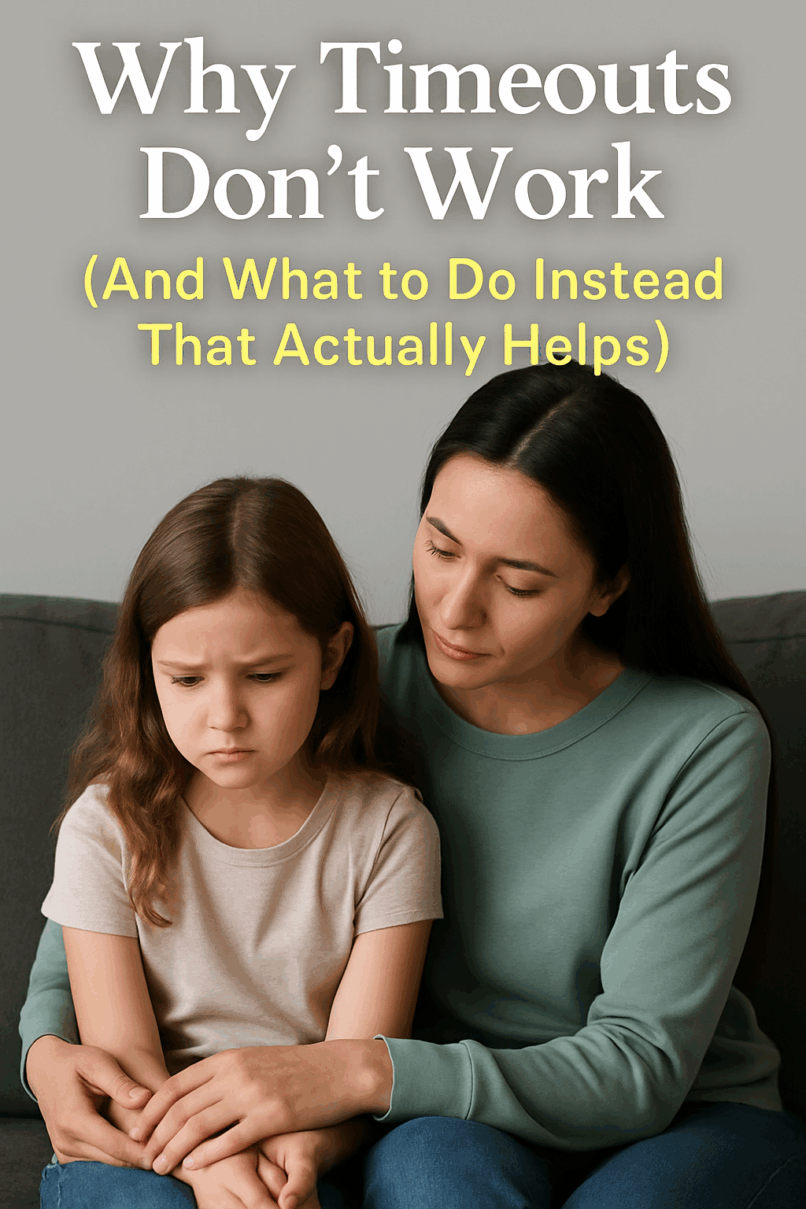
simply amazing, always for you.
Every parent wants their child to grow up kind, confident, and respectful. But the road to raising emotionally intelligent children isn’t always smooth. One of the biggest challenges parents face is discipline: how do you correct misbehavior in a way that actually teaches, rather than punishes?

For decades, the “timeout” has been one of the most widely recommended discipline tools. It’s simple, non-violent, and seemingly effective. But in real life, many parents find themselves stuck in a cycle of repeated timeouts, only to watch behavior problems get worse — not better.
If you’ve ever wondered why your child keeps acting out despite countless timeouts, you’re not alone.
This article explores why timeouts often fall short, how they can affect your child emotionally, and what alternative discipline strategies are more effective in fostering long-term growth, cooperation, and connection. If you’re ready to move beyond timeout chairs and power struggles, you’re in the right place.
What Is a Timeout, Really?
A timeout is a form of discipline where a child is removed from a situation to reflect on their behavior, ideally in a quiet, unstimulating space. It’s typically used when a child misbehaves, and the idea is to separate them from attention or reinforcement for a short time (usually 1 minute per year of age).
At face value, timeouts are intended to teach children that misbehavior has consequences. The theory is that when you remove a child from fun, connection, or interaction, they’ll learn to avoid that behavior next time.
But does it actually work?
Why Timeouts Aren’t Always Effective
Time-outs are not inherently harmful or wrong. In fact, when used occasionally with the right emotional tone and purpose, they can be useful. However, many parents use them reactively or routinely, without understanding how they might be backfiring.
Here’s why timeouts often fall short:

1. Timeouts Disconnect Instead of Connect
Children misbehave for many reasons — they’re overwhelmed, hungry, tired, feeling ignored, or struggling to express emotions. In most cases, what they need isn’t isolation — it’s connection.
When you send a child away during emotional distress, it teaches them that they’re only welcome when they behave. This erodes trust and security, especially in younger children.
Instead of seeing the behavior as a cry for help, timeouts say: “Figure it out alone.”
Want to learn how to respond more patiently during these moments? Read How to Be a Patient Parent: Tips for Managing Your Emotions.
2. Timeouts Can Create Shame
When used repeatedly, especially in anger or frustration, timeouts send the message: “You’re a problem.” This can lead to internalized shame — the feeling that they are bad, not just their actions.
Shame doesn’t lead to better behavior. It leads to secrecy, fear, anxiety, and emotional withdrawal.
Discipline should never make a child feel small. Instead, it should help them grow.
3. They Don’t Teach the Right Behavior
Timeouts stop the unwanted behavior, but they don’t teach what to do instead. Children need clear guidance, not just punishment. Without positive instruction, they may continue misbehaving out of confusion or frustration.
Just telling a child what not to do isn’t enough. They need to know what’s expected and how to succeed.
Check out How to Discipline Your Child Without Yelling or Punishing to explore methods that are constructive rather than reactive.
4. Timeouts Often Escalate Power Struggles
Most parents know the dreaded standoff — the child refuses to go to timeout, screams louder, or tries to run away. What was supposed to be a calm teaching moment turns into a power struggle.
For spirited children or those with big emotions, timeouts can trigger even more defiance, making things worse.
5. They Assume Kids Can Self-Regulate Alone
Children — especially toddlers and preschoolers — don’t have fully developed brains capable of self-soothing on their own. Asking them to “think about what they did” during a timeout is often developmentally inappropriate.
Expecting a child to calm themselves without support is like expecting a toddler to build a bridge without tools.
Instead of punishing dysregulation, we should help them regulate. That’s where time-ins come in.
What to Do Instead: Alternative Discipline Strategies That Work
So what can you do when your child pushes boundaries, acts out, or melts down?
The good news: there are plenty of research-backed alternatives that are far more effective — and emotionally supportive.
Let’s walk through the most powerful discipline strategies beyond timeout.
1. Time-Ins: Calm Together, Not Apart
In a time-in, the parent stays close to help the child co-regulate. Instead of isolation, you offer presence, empathy, and guidance.
What it looks like:
“You’re having a hard time. Come sit next to me. Let’s breathe together and figure this out.”
Time-ins teach emotional safety and give children the tools to regulate, rather than leaving them to figure it out alone.
2. Logical Consequences
Unlike arbitrary punishment, logical consequences are directly related to the behavior.
If your child throws food, the meal ends. If they write on the wall, they help clean it. Logical consequences are fair, respectful, and rooted in cause and effect.
They help children learn responsibility in a calm, non-shaming way.
3. Redirection and Reframing
Young children are impulsive by nature. Often, they need help channeling their energy, not being punished for it.
Instead of saying “Stop jumping on the couch!” you might say, “Couches are for sitting — let’s jump outside or on the trampoline.”
This strategy respects their developmental need for movement while teaching boundaries.
Learn more quick tricks in 10 Simple Parenting Hacks Every Mom and Dad Should Know.
4. Collaborative Problem Solving
Instead of doing discipline to your child, try working with them.
After things have calmed down, sit together and say:
“It seems like bedtime is really hard. Can we talk about what might make it easier for you?”
This builds problem-solving skills, mutual respect, and accountability.
For help with setting firm, kind limits, check out How to Set Boundaries with Your Children (Without Feeling Bad).
5. Natural Consequences
Sometimes, life teaches better than we can. If your child forgets their toy in the rain, it gets wet. If they refuse to wear a coat, they feel cold.
As long as safety isn’t compromised, natural consequences are incredibly effective teachers.
6. Emotion Coaching
Behavior is communication. When children misbehave, they’re often expressing big emotions in small, messy ways.
Instead of reacting, try reflecting:
“You were really upset when your brother took your toy. It’s okay to be mad, but not okay to hit.”
Then model better coping skills: breathing, taking space, using words.
7. Offer Choices
When kids feel powerless, they act out. Offering small choices empowers them within safe boundaries.
“You can brush your teeth now or after you put on pajamas. Which one do you choose?”
This avoids power struggles and fosters cooperation.
8. Model the Behavior You Want to See
Kids imitate more than they listen. If you yell, they’ll yell. If you show respect and calm, they will too — eventually.
Narrate your regulation:
“I’m getting frustrated, so I’m going to take a deep breath.”
This shows emotional intelligence in action.
9. Positive Reinforcement
What you focus on grows. Catch your child being kind, patient, or cooperative — and say so.
“I saw you share your crayons even though you didn’t want to. That was generous.”
Genuine praise builds confidence and motivation to do better.
10. Build in Daily Connection
Many behavior issues stem from disconnection. Proactive one-on-one time can prevent a lot of misbehavior.
Just 10–15 minutes a day of child-led time (where they choose the activity and you’re fully present) works wonders.
Learn more about why this matters in How to Balance Parenting and Personal Time Without Feeling Guilty.
Transitioning Away from Timeouts: A Gentle Guide
If you’ve used timeouts regularly, shifting to a new approach may feel unfamiliar — even scary. Here’s how to make the switch with confidence and grace:
- Talk to your child: “We’re going to try something new when you’re upset. I want to help you feel better, not send you away.”
- Introduce time-ins: Stay close during hard moments. Breathe together. Be a calm anchor.
- Practice emotional vocabulary:
Use books, emotion charts, or storytelling to help your child identify what they feel. - Be consistent and patient:
New habits take time. You’re not going to get it perfect every time — and neither will your child.
If you’re feeling worn out, visit How to Deal with Parenting Burnout and Find Your Energy Again. You’re not alone, and you can recover your calm.
When Discipline Is Rooted in Love, It Works
Discipline isn’t about control — it’s about guidance. It’s not about forcing compliance, but fostering internal motivation, empathy, and resilience.
When we abandon reactive discipline like timeouts and embrace thoughtful alternatives, we raise children who know how to regulate, connect, and take responsibility.
Timeouts aren’t inherently evil — but they’re rarely effective as a standalone discipline tool.
Children need more than silence and isolation. They need support, structure, and connection.
By shifting to discipline strategies that respect your child’s emotions and development, you’re building something far more powerful than obedience — you’re nurturing lifelong emotional intelligence.
And remember, parenting isn’t about perfection. It’s about showing up, learning as you go, and doing better with what you now know.

Support Our Website!
We appreciate your visit and hope you find our content valuable. If you’d like to support us further, please consider contributing through the TILL NUMBER: 9549825. Your support helps us keep delivering great content!
If you’d like to support Nabado from outside Kenya, we invite you to send your contributions through trusted third-party services such as Remitly, SendWave, or WorldRemit. These platforms are reliable and convenient for international money transfers.
Please use the following details when sending your support:
Phone Number: +254701838999
Recipient Name: Peterson Getuma Okemwa
We sincerely appreciate your generosity and support. Thank you for being part of this journey!
